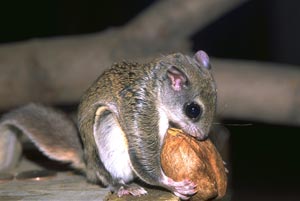 The southern flying squirrel inhabits deciduous and mixed forests in the eastern United States and west as far as eastern Texas. They mate twice a year, once during February and March, and again from late May through July. Two litters a year are only produced during favorable conditions, and from three to seven young are born per litter. They prefer abandoned woodpecker holes, but may be encouraged to an area by the use of nest boxes if such tree cavities are in short supply. Nest boxes do not need to be designed specifically for flying squirrels. At my farm in Greene County, I had a colony of approximately eight inhabiting an old Purple Martin house mounted on top of a light pole.
The southern flying squirrel inhabits deciduous and mixed forests in the eastern United States and west as far as eastern Texas. They mate twice a year, once during February and March, and again from late May through July. Two litters a year are only produced during favorable conditions, and from three to seven young are born per litter. They prefer abandoned woodpecker holes, but may be encouraged to an area by the use of nest boxes if such tree cavities are in short supply. Nest boxes do not need to be designed specifically for flying squirrels. At my farm in Greene County, I had a colony of approximately eight inhabiting an old Purple Martin house mounted on top of a light pole.
Totally nocturnal, these diminutive squirrels weigh from two to four ounces and are from nine to ten inches in length. They consume more meat than other squirrels, and their diet consists of acorns, nuts, berries, seeds, mushrooms, and eggs as well as many insects, young birds, and carrion. They have also been observed feeding on bird feeders at night.
They do not actually fly but glide using a membrane called a patagium that extends from their wrists to their ankles. Using their tail as their major braking and steering medium, they are capable of making turns of up to 180 degrees. They can glide three horizontal feet for every vertical foot. This would allow them to travel the length of a football field from a tree one hundred feet in height!
